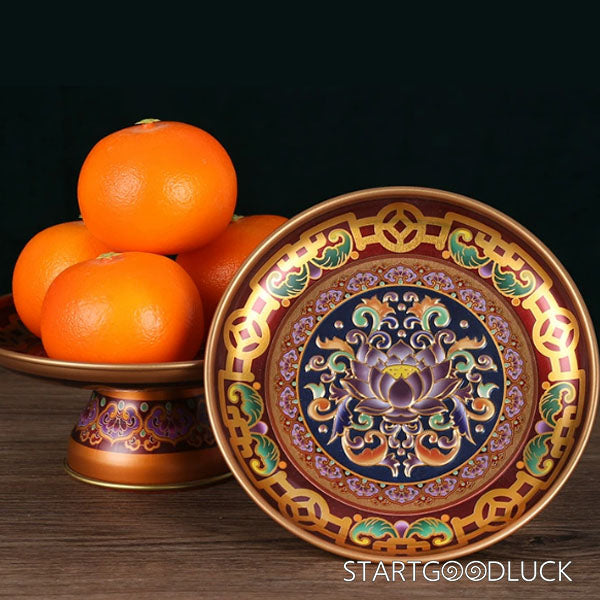These Enameled Buddhist Fruit Offering Plates are exquisitely crafted ritual tools for Buddhist practices. Adorned with vibrant lotus patterns and auspicious symbols, they blend traditional artistry with spiritual significance. Available in two designs—one featuring a sacred lotus, the other inscribed with the Chinese character for “wealth - attracting” —these plates create a dignified and blessed atmosphere for offerings.
What It Is
In Buddhist traditions, fruit offerings are a core practice to express reverence to Buddhas, Bodhisattvas, or enlightened beings. These plates serve as vessels for fresh fruits (e.g., apples, oranges, bananas), symbolizing the offering of purity, gratitude, and “the sweet fruits of virtue.” The lotus design represents spiritual enlightenment, while the “wealth - attracting” motif adds a layer of cultural symbolism for prosperity—aligning material blessings with spiritual devotion.
How to Use
Prepare the Altar: Place the plates on a clean, quiet altar space. Arrange them symmetrically (e.g., side by side or in a row) to create a harmonious display.
Select & Arrange Fruits: Choose fresh, clean fruits (avoid overripe or damaged ones). Wash and dry them, then place them neatly in the plates—arrange in a single layer for balance and respect.
Offer with Devotion: Light incense or candles (if part of your ritual), bow gently, and recite prayers/mantras (e.g., Namo Amitabha Buddha). Visualize the fruits as offerings of your sincerity, inviting blessings for wisdom, peace, and well - being.
Maintain Freshness: Replace fruits daily or as they ripen to honor the practice of “continuous offering.”
Effects & Significance
Spiritual Connection: The plates bridge the physical and spiritual realms—offering fruits is a tangible way to express devotion, fostering a deeper connection to enlightened beings.
Cultivate Virtues: By offering fruits, you practice generosity (Dāna) and mindfulness, aligning with Buddhist values of compassion and gratitude.
Auspicious Symbolism: The lotus represents purity rising from worldly “mud,” while “wealth - attracting” merges cultural hopes for prosperity with spiritual practice—reminding you that true wealth includes inner peace.

